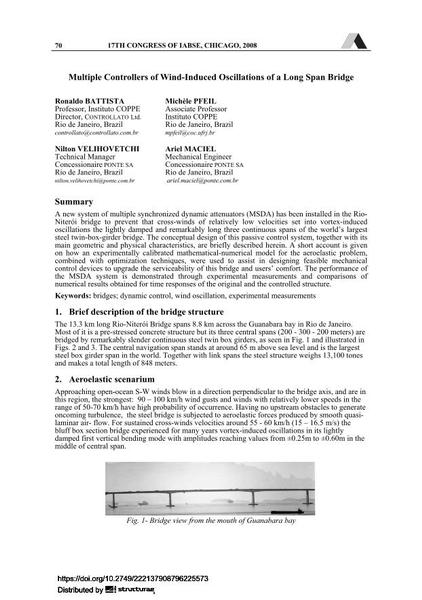Multiple Controllers of Wind-Induced Oscillations of a Long Span Bridge

|
|
|||||||||||
Bibliografische Angaben
| Autor(en): |
Ronaldo Battista
Michèle Pfeil Nilton Velihovetchi Ariel Maciel |
||||
|---|---|---|---|---|---|
| Medium: | Tagungsbeitrag | ||||
| Sprache(n): | Englisch | ||||
| Tagung: | 17th IABSE Congress: Creating and Renewing Urban Structures – Tall Buildings, Bridges and Infrastructure, Chicago, USA, 17-19 September 2008 | ||||
| Veröffentlicht in: | IABSE Congress Chicago 2008 | ||||
|
|||||
| Seite(n): | 70-71 | ||||
| Anzahl der Seiten (im PDF): | 8 | ||||
| Jahr: | 2008 | ||||
| DOI: | 10.2749/222137908796225573 | ||||
| Abstrakt: |
A new system of multiple synchronized dynamic attenuators (MSDA) has been installed in the Rio- Niterói bridge to prevent that cross-winds of relatively low velocities set into vortex-induced oscillations the lightly damped and remarkably long three continuous spans of the world’s largest steel twin-box-girder bridge. The conceptual design of this passive control system, together with its main geometric and physical characteristics, are briefly described herein. A short account is given on how an experimentally calibrated mathematical-numerical model for the aeroelastic problem, combined with optimization techniques, were used to assist in designing feasible mechanical control devices to upgrade the serviceability of this bridge and users’ comfort. The performance of the MSDA system is demonstrated through experimental measurements and comparisons of numerical results obtained for time responses of the original and the controlled structure. |
||||
| Stichwörter: |
Brücken
|
||||
